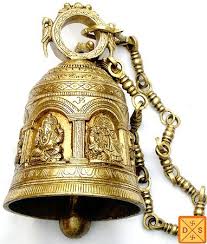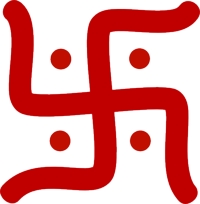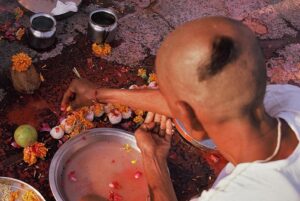
India is regarded by many historians as the “oldest living civilization of Earth”. Indian traditions and culture are the world’s richest as it unveils an amazing range of historical stories that astounds the imagination. Ancient concepts like karma, dharma, atma (re-birth) and Yoga still govern daily lives of Indians, hence an explanation is due.
Why visit temples and do a ‘pradakshina’?
Generally, temples are strategically located in a place where earth’s magnetic waves pass through i.e. where the positive energy is abundantly available from the magnetic wave distribution of north/ south pole thrust. Because of its location, where high magnetic values are available, the main idol is placed in the centre known as “garbha griha” or “moola sthana”. Also, a copper plate written with Vedic scripts is beneath the main idol. The copper absorbs the earth’s magnetic waves and radiates the energy to the surroundings.
Thus, a person who regularly visits a temple and makes clockwise ‘pradakshina’ of the main idol’s placement, automatically receives the beamed magnetic waves which get absorbed by his body. This is very slow and a regular visit will make him absorb more energy, known as positive energy. In addition, the central sanctum sanctorum is completely enclosed on 3 sides. The effect of all energies is very high in here.
The lamp that is lit radiates the heat and light energy. The fragrance from the flowers, the burning of camphor gives out chemical energy. The ringing of the bells and the chanting of prayers gives sound energy. The effect of all these energies is activated by the positive energy that comes out of the idol. This is in addition to the north/ south pole magnetic energy that is absorbed by the copper plate and utensils that are kept in the ‘moola sthana’.
“Teertham”, the water used for the pooja is mixed with cardamom, holy Tulasi (basil), cloves, etc. This water becomes more energized because it receives the positive-ness of all these ingredients combined. When persons go to the temple for dweepa araadhana, and when the doors open up, the positive energy gushes out onto the persons who are there. The water that is sprinkled onto the people passes on the energy to all. That is the reason why, men are not allowed to wear shirts to the temple and ladies have to wear more ornaments because it is through these jewels (metal) that positive energy is absorbed in ladies. It is proven that teertham is a very good blood purifier, as it is highly energized.
In addition, temples offer holy water (about three spoons). This water is mainly a source of magneto therapy as they place the copper water vessel at the ‘garbha griha’. It also contains cardamom, clove, saffron, etc to add taste and Tulasi (holy Basil) leaves are put into the water to increase its medicinal value! The clove essence protects one from tooth decay, the saffron & Tulasi leave essence protects one from common cold and cough, cardamom and benzoine known as pancha karpuram, acts as a mouth refreshing agents. This way, one’s health too is protected, by regularly visiting temples!
 Ghantaa naadam (ringing of the bell)
Ghantaa naadam (ringing of the bell)
Ghantaa (bell) has a significant place in the process of worship. While the bell made of gold and silver produce mild sound it is said that the bells made of copper or brass help in controlling the evils and germs. Its ringing also helps to quiet the thoughts running in your mind, before you sight (‘darshan’) the deity.
Why do we do ‘abhishekam’?
Normally, abhishekam (bathing the idol) is performed to the idols with pancha amrita, which is a mixture of cow milk, curds, pure ghee, sugar and honey. Some devotees also mix banana and coconut water in pancha amrita. After completing the abhisheka, the pancha amrita is consumed by the devotees as teertha. It is said that pancha amrita has medicinal values and will provide health and nourishment to the body. However, since it is used for worshipping the god, there are spiritual values too attached to this teertha.
Why do we do an ‘aarti’ and garlanding?
Performing aarti and garlanding are acts of veneration and love for the deity. Aarti consists of a dish that carries 5 small metal lamps along with cotton, few rice grains and arecanut. A conch-shell filled with water, auspicious leaves or flowers, incense or lighted camphor are also placed in the tray. The lamps are lit and the tray is rotated in a circular motion in front of the deity or the person to be welcomed. The purpose of performing aarti is to ward off negative energies and the wicked effects of the ‘evil eye’. The camphor fire and flower garlands give out chemical energies that can absorb the negative energies.
Only ghee must be used (better than oil), as Agni Purana states that ghee is more saatvika than oil, attracting more saatvika vibrations and its effect can be felt many hours after burning. Ghee lamp also activates the naadi which is most essential to the worshipper and also strengthens the Pranamaya kosha and Manomaya kosha.
Lastly, a straight wick (waat) should be used instead of a puffed wick or fulwaat (which offers stability to stand in the centre), because vibrations emitted from straight wick are in the form of waves v/s circular waves of the fulwaat, which is better to attract saatvika vibrations.
Why do we remove shoes while entering a temple or a home or a kitchen?
Shoes are considered dirty in India, so we take off our shoes before stepping into someone’s house or their kitchen. We don’t step on anything important and if you do, we immediately express our apologies.
Why do a ‘Namaskar’ or ‘Namaste’?
Namaste, namaskar or namaskara or namaskaram, vanakkam (Tamil), nomoshkaar (Bengali), nomoskar (Assamese) is a common spoken greeting or salutation, expressing deep respect. However, the same hands folded gesture is made usually wordlessly upon departure. The word is derived from Sanskrit (namah): to bow, obeisance, reverential salutation, and respect, and (te): “to you”. Namaste refers to ‘that which is of God in me bows to that which is of God in you’.
In the modern context, wouldn’t it be more hygienic to offer a ‘Namaskar’, instead of shaking hands? In most Indian families, younger men and women are taught to seek the blessing of their elders by reverentially bowing to their elders. This custom is known as pranama.
Why do we take a bath daily?
Apart from personal hygiene there are other aspects too. Maharshi Vatsyayana has described the various power centres and electric impulses in a human body. A continuous process of generation and consumption of electric energy takes place in the human body. Polygraphic studies proved that water enhances electro-magnetic activity. In the context of this finding, the religious practices like washing hands and feet before entering temples and taking bath everyday, worshipping with wet clothes and offering prayer standing in the middle of water chest-deep in rivers and tanks etc., seem to be more scientific than a mere act of cleanliness.
Why should we meditate or read during ‘Braahmi Muhurtham’?
The time 90 minutes prior to sunrise is called Braahmi muhurta. ‘Braahmi’ means Saraswati, the Goddess of intellect. The above specified time is auspicious for gaining and sustaining intelligence and knowledge, owing to which it is called Braahmi muhurta. It is during Braahmi muhurta that Sun god spreads his light rays, which bring to life the cells and the brain. If the man can synchronize his senses with these rays during this hour he will be empowered with unchallengeable electrical and magnetic energy. This observation was endorsed by sages.
 Why do men do a ’tilak’ and married women a ‘bindi’ and ‘mangalsutra’?
Why do men do a ’tilak’ and married women a ‘bindi’ and ‘mangalsutra’?
The tilak or a bindi is applied on the spot between the brows which is considered the seat of latent wisdom and mental concentration, and is very important for worship. This is the spot on which yogis meditate to become one with Lord Brahma. It also indicates the point at which the spiritual eye opens. All thoughts and actions are said to be governed by this spot. Putting of the coloured mark symbolizes the quest for the ‘opening’ of the third eye. All rites and ceremonies of the Hindus begin with a tilak topped with a few grains of rice placed on this spot with the index finger or the thumb. The same custom is followed while welcoming or bidding farewell to guests or relations.
A bindi, applied on the forehead on the third eye, signifies pleasantly the subsistence of her beloved husband. Is it used as a charm to ward off evil by unmarried girls? Could be, because it could compel other unknown men to focus on the bindi rather than on her body.
The same logic may apply to the mangalsutra (auspicious thread) worn around the neck, as it consists of black beads along with a gold pendant. The black beads are believed to act as protection against evil. Gold helps increase energy levels in the body and is symbol of prosperity. Married women wear this to protect their marriage and the life of their husband. In southern India, the mangalsutra is called ‘tali’.
Use of festoons (toranam) and turmeric at the door-steps
Indians use a festoon (toranam) made of fresh and green mango leaves or Neem leaves at the main door of the houses or temples. The air filled with carbon dioxide, which is lighter than the pure air, gets purified immediately while passing through the festoon. In addition, insects get attracted to the green leaves. This stops the insects from entering the room. It is beyond doubt that turmeric has anti-septic and anti-bacterial characteristics. Turmeric applied on the door sill stops bacteria or other microscopic organisms from making their way into the house. Turmeric checks every invisible organism. In addition, the yellow colour makes the main door colourful and is an aesthetic combination for the green festoon on the top of the door frame.
Why do Hindus prefer to eat in private?
When anyone stares at someone or something excessively with a negative intention, the negative vibrations get focused with concentration on the person or thing and cause damage. A hungry man with an evil eye is believed to poison another’s food with his wicked stare. That is the reason why people like to eat in privacy.
 What is the importance of ‘swastika’?
What is the importance of ‘swastika’?
In the Ganesh Purana, it is said that the swastika is a form of Lord Ganesha, the remover of all obstacles. In the Amarkosh, swastika is referred to as a pure and auspicious blessing. In one of the hymns in the Rig Veda it is said that the swastika is symbolic of Surya (Sun). People also consider the swastika (‘satiya’ or symbolic of the Sudarshan Chakra) as a symbol denoting plus (+) or prosperity.
Religious texts explain that the eight arms of the swastika are symbolic of the earth, fire, water, air, sky, mind, emotions and feelings.
The 4 main arms point in 4 directions. The 4 dots represents the four eras – Satyuga, Tretayuga, Dwaparyuga and Kaliyuga. The 4 arms or dots also represents the 4 interdependent varna-s: Brahmana-s, Kshatriya-s, Vaishya-s and Shudra-s, OR the 4 ashrams of life too – Brahmacharya, Grihasta, Vanaprastha and Sannyasa.
The 4 arms are also symbolic of the 4 basic aims of human pursuit – Dharma (righteousness), artha (prosperity), kaama (passion) and moksha (salvation). They are also symbolic of the 4 faces and 4 hands of Brahma and of the 4 Vedas – Rig Veda, Yajur Veda, Sama Veda and Atharva Veda.
In this way, the swastika is really symbolic of all the directions and of Gods and auspicious circumstances.
Why do many Hindu rituals worship a kumari kanya?
Hinduism believes in the universal creative forces to be feminine gender. The very original force is Mahamaya whose inspiration created the gods and the rest of the cosmos. All the major and minor energies and forces are represented by various goddesses. Navratra deity Durga and all her dimensions are believed to be the manifestations of the same basic inspiration Mahamaya. Thus, a virgin girl is worshipped as a symbol of the pure basic creative force.
Why do prayer beads number 108?
Meru bead is a larger bead, not part of the 108 prayer beads. It is not tied in the sequence of the other beads. It is the guiding bead, the one that marks the beginning and end of the mala. It is also the custom not to cross over the Guru bead (top bead), but to go back and forth. Any mantra recited with the traditional Hindu prayer beads (mala having 108 beads) will be enhanced, due to several reasons like:
- The diameter of the Sun is 108 times the diameter of the Earth. The distance from the Sun to the Earth is 108 times the diameter of the Sun.
- The average distance of the Moon from the Earth is 108 times the diameter of the Moon.
- In astrology, there are 12 constellations or houses and 9 planets or arc segments. 12 times 9 equals 108.
- In a human body, chakra-s are the intersections of energy lines, and there are said to be a total of 108 energy lines converging to from the heart chakra. One of them, sushumna leads to the crown chakra, and is said to be the path to Self-realization.
- Tantra estimates the average number of breaths per day at 21,600, of which 10,800 are solar energy, and 10,800 are lunar energy. Multiplying 108 by 100 is 10,800. Multiplying 2 x 10,800 equals 21,600.
- On the Sri Yantra there are marma-s where 3 lines intersect, and there are 54 such intersections. Each intersections has masculine and feminine, Shiva and Shakti qualities. 54 times 2 equals 108. Thus, there are 108 points that define the Sri Yantra as well as the human body.
- There are 54 letters in the Sanskrit alphabet. Each has masculine and feminine, Shiva and Shakti. 54 times 2 is 108.
- 108 is a harshada number, which is an integer divisible by the sum of its digits (harshada is Sanskrit for “great joy”)
 Why should we perform shraada?
Why should we perform shraada?
Repaying the debt to ancestors is as important as repaying the debt to God, sages and the society. It is the duty of descendants to respect their ancestors, make donations in their name and to undertake activities that will please them. Performing shraada is a part of obeying Dharma. Ancestors’ soul becomes satisfied only after receiving pinda and water from their son.
If soul of a deceased person wishes that ‘someone should perform shraada for me’ and if it does not get fulfilled from the expected descendant, then it becomes unhappy due to non-fulfillment of the desire. Such soul can transform into an evil spirit (a type of negative energy) and cause distress to its relatives for not performing the ritual of shraada.
The spiritually potent mantras that are chanted during the ritual of shraada have the subtle power of providing momentum to the subtle bodies of deceased ancestors therefore they can progress to a higher sub-plane of existence after the ritual is performed.
Why do we fast on Ekadashi (eleventh lunar day of the Hindu calendar)?
On Full Moon Day the ocean waves are higher. Nearly 60% of our body is made up of water, and it has saline content, just like in the ocean. So your body is a miniature capsule of sea water. So the Moon also has an influence on the body and anything that influences the body influences the mind as well. That is why people who go crazy are called lunatics.
So, when the stomach is kept empty the toxins in the body get cleared. Fasting has a purifying effect on the body and it cleanses all the undigested food, toxins, etc. So if you fast three days before Full Moon (most optimum day), you will not have any illnesses.
Other traditions:
- ‘Joint family’ is a notable feature of Indian families. Researchers have noted that people who do not belong to cohesive families have fewer coping resources and increased levels of social and psychological stress. Psychological stress is associated with heart disease, various cancers and increased mortality risk. Indians shed emotional stress exceptionally well, due to the familial support which they receive and contribute to.
- We never to pass on anything – money or a gift – to an Indian with your left hand, which is used for cleaning up.
- The Kshatriya-s followed the worship of weapons. On special days double-edged swords are removed from the house of arms and the entire court pays its respects.
- Traditional Hindu prayer beads known as mala (garland of flowers), are made from Rudraksha, the dried fruit of the Elaeocarpus Ganitrus. Rudraksha translates as “Shiva’s Eye”. It is said that Shiva sat in open-eyed meditation for 1,000 years. When he finally blinked, the tears that streamed from his eyes became Rudraksha seeds. The surface of the seed is rough and represents the austere life the Siva worshipper must follow. The rudraksha seed is segmented into five sections. Seeds with a differing number of segments are sought after.
